Pha Khao Ma: Thai Way of Life Encapsulated in a Piece of Fabric
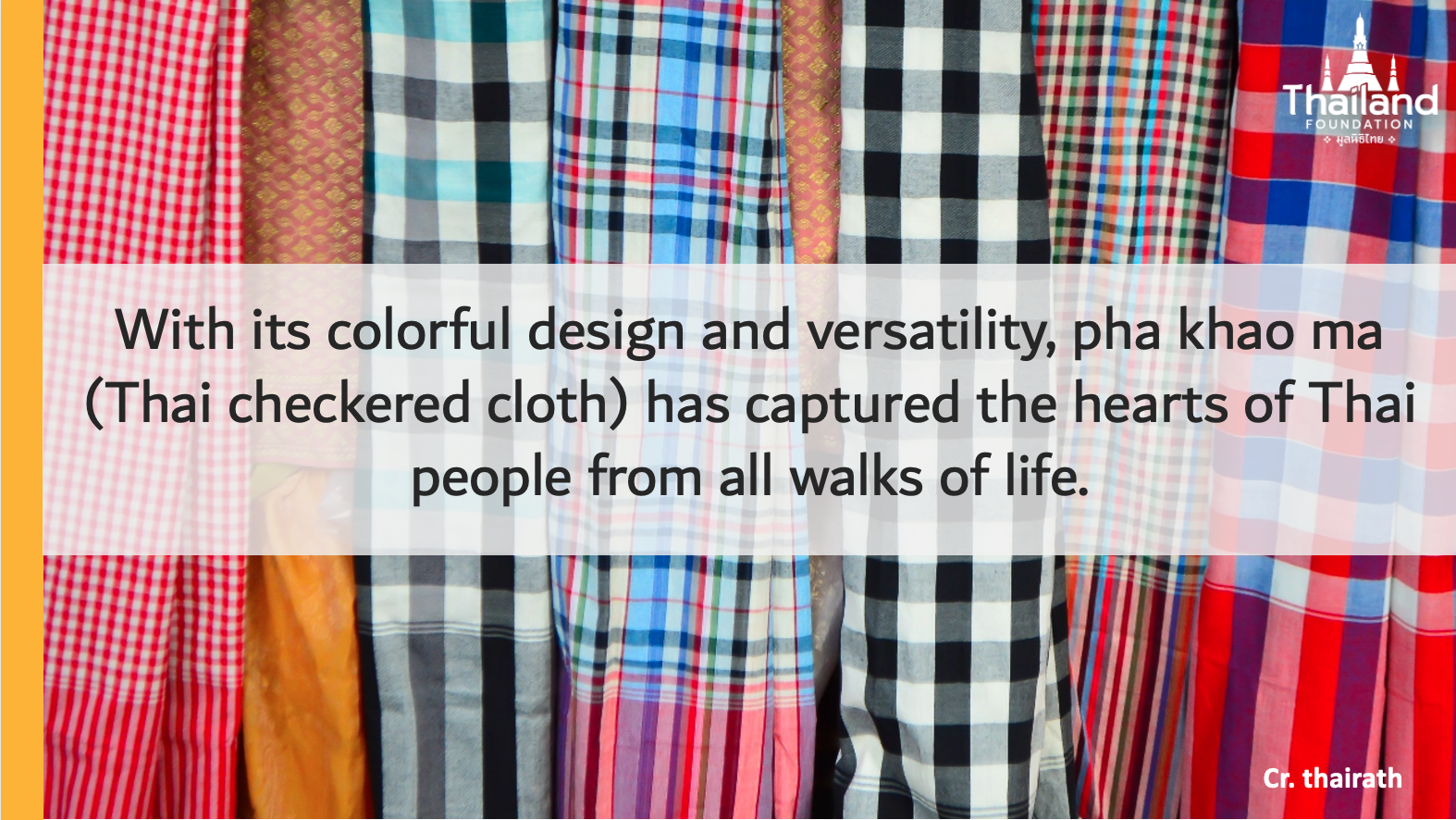
If you are in Thailand for quite some time, you must have come across colorful checkered cloth, and you may wonder “what do Thai people do with this thing and why do I see it everywhere?” Well, brace yourself as we unravel the tale of pha khao ma, a cloth that is so much more than meets the eye. By the end of this article, you will be surprised by how this single piece of cloth has woven itself into the very fabric of Thai life.
What is Pha Khao Ma?
Pha khao ma (ผ้าขาวม้า) or Thai checkered cloth is a traditional textile widely used all over Thailand. Wherever you venture in this country, it’s virtually impossible to miss the distinctive sight of pha khao ma. This rectangular woven cloth, measuring around 75 centimeters wide and 125 centimeters long, has a unique colorful checkered pattern that sets it apart from other traditional textiles. Each province also adds its own creative twist to pha khao ma, resulting in exclusive patterns and colors that reflect the unique preferences of the local communities. In terms of the material, although dyed cotton is most widely used, some places also weave the cloth with unbleached cotton, polyester, acrylic yarns, or silk, depending on the style and purpose of the cloth.
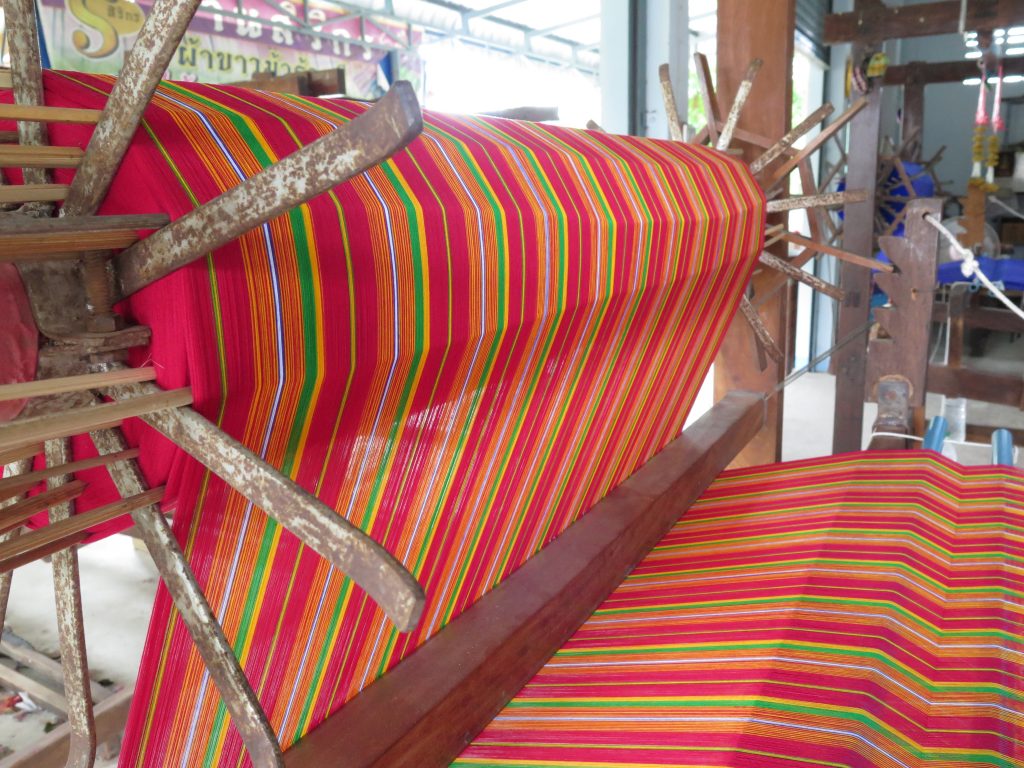
pha khao ma (Cr. communityarchive)
Pha Khao Ma in different regions
- The Central Region
One of the most popular designs of pha khao ma in this region is called pha khao ma roi si (ผ้าขาวม้าร้อยสี) which means checkered cloth with one hundred colors. Unique to Nong Khao District in Kanchanaburi Province, the cloth is woven with many dyed acrylic yarns, making the cloth looks shiny and smooth like silk. When the threads of many colors overlap, new shades are created, resulting in a colorful, vibrant, and eye-catching piece of fabric.
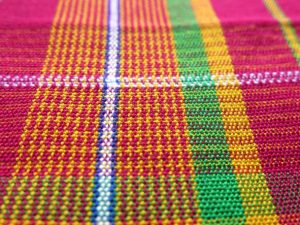
pha khao ma roi si (Cr. communityarchive)
- The Northern Region
The Northern region is famous for its gimmick in the pattern of pha khao ma. Although a major part of the fabric still features the famous checkered pattern, the lower portion becomes a canvas for special patterns from the Northern traditional weaving technique. The patterns, such as birds, elephants, horses, or even stupas, vary according to the values and beliefs of each community. So, next time you visit the Northern region, you can give yourself a little challenge and find out how many different patterns you can spot during your trip!
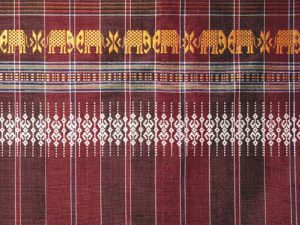
pha khao ma with elephant patterns (Cr. ประชารัฐรักสามัคคี)
- The Northeastern Region
In the Northeastern region, where pha khao ma is frequently used in the locals’ daily lives, two main patterns take their place in the locals’ heart. The first one, as you can guess, is a checkered pattern. However, while people in the Central region love this design with big squares, the people here prefer smaller ones. Another popular pattern is stripes of many colors, which is called sai pla lai (ไส้ปลาไหล) or eel’s intestine as they believe the pattern resembles an eel, one of the staple foods in this region, after when it is prepared as a food ingredient.
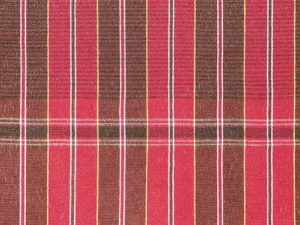
sai pla lai (Cr. ประชารัฐรักสามัคคี)
- The Southern Region
Although the pattern of pha khao ma isn’t much different from that of other regions, the quality of the cotton used in weaving it is excellent. Especially if you have a chance to visit Koh Yor in Songkla, don’t forget to try it on!
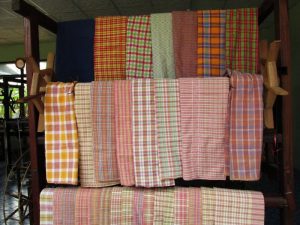
(Cr. matichonweekly)
Although this traditional hand-woven cloth has many different patterns and characteristics according to each region’s preferences, we can divide them into four main categories:
- Checkered pattern with large squares
- Checkered pattern with small squares
- Stripes or eel intestine pattern
- Ta Moo (ตาหมู่) which is a combination of small, checkered squares and stripes
The Versatility of Pha Khao Ma
Of course, the popularity of pha khao ma among the Thai doesn’t only have its root from the cloth’s captivating appearance, but mostly from its multiple functions. It’s safe to say that this single piece of cloth plays an important role in Thai people’s lives ever since we were born. Guess the purpose of pha khao ma, and all your answers will probably be right: to wear, to clean, to decorate, to give out as gifts, to use in rituals, you name it. In this article, we will scope it down to three main categories:
- Garments
Sometimes called loincloth, pha khao ma, whose soft cotton texture is suitable for hot weather, is traditionally used to wrap around the waist as a sarong. Or if they already wear a sarong, Thai men often tie pha khao ma tightly around their waists as a belt, or just drape it across their shoulders when they are out for work in the field and put it to various uses such as wiping away sweat, shielding their heads from the scorching sun, creating a makeshift fan, warding off insects, or even acting as a bandage in case of injuries. Additionally, this versatile piece of fabric can be worn as pants by wrapping it around the waist, folding it up, tucking the tail under the legs, and securing it at the back. For women, pha khao ma can be folded and wrapped around their torso, transforming into a strapless top.
In the past, Thai people usually took a shower outside as our traditional wooden house doesn’t come with a built-in bathroom, so we cleaned up with the water from a big earthen jar in front of their house or in a river or a canal. Pha khao ma can then serve as a bathrobe and towel.
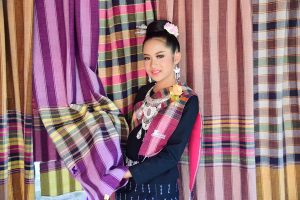
(Cr. anurakmag)
- Everyday necessities
Pha khao ma has become an integral part of our lives. Since we were just babies, we have already familiarized ourselves with this woven cloth. Parents often use pha khao ma as a baby cradle, and when they need to go outside, they can wrap the fabric around the babies, transforming it into a convenient baby carrier as well! Moreover, mothers can utilize it as a nursing cover when they need to breastfeed their baby in public.
As we grow up, the utilities of pha khao ma expand. For one thing, we can wrap it around our miscellaneous things and carry it as a bag. In the old days, Thai people also wrapped the fabric around weapons like knives and axes, not only to hide them but also to protect themselves from being cut.
For another thing, if we work outside and feel like sitting down, but there is not a single chair or bench in sight, we can easily spread a large-sized pha khao ma and lay it in the shade. Now, we get a sitting or sleeping mat. And if we happen to have an extra one? Even better! That piece of cloth can serve as a blanket or a pillow!
During a meal, pha khao ma can be used as a napkin or laid as a tablecloth. The good thing is even if it is dirty from the food, the stain can be washed off and with the cloth’s vibrant colors, it won’t be that visible. Once the cloth becomes worn out and soiled, it can be repurposed as a rag or a cleaning cloth. See how practical and sustainable this versatile fabric is!
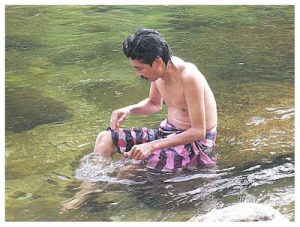
A man using pha khao ma for bathing in the river (Cr. บ้านสวนแม่นิภา)
- In rituals and ceremonies
As pha khao ma is indispensable for Thai people’s lives, it is also integrated into Thai rituals — another thing that we find important.
If you visit the Northeastern region, don’t be surprised to receive pha khao ma as a welcoming gift from your friends or their family. Giving out the fabric that plays such a crucial role in our lives to our guests shows our hospitality and willingness to welcome them to be a part of our community. Therefore, it’s a common sight to see politicians get a nice piece of pha khao ma wrapped around their waists when they visit the provinces in this region!
There is also a belief among the locals in the Northeastern region that the pha khao ma one owns can have an impact on our lives, so it’s important to choose one wisely. To determine whether that piece of cloth is good or bad for them, they will perform a ritual. If the result turns out good, it is believed that the owner will be lucky and loved by people around him or her; however, if the it is bad, it means that the cloth isn’t auspicious and may bring bad luck or sickness to the owner. This ritual exemplifies how pha khao ma isn’t considered just an everyday object but a kind of “life partner” for the locals.
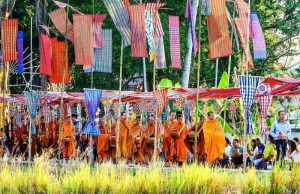
(Cr. thailandplus)
During the Buddhist ordination ceremony, pha khao ma is laid on the floor for the “monk to be” to perform the wai gesture to their parents as a symbol of paying respect. At the same time, it will be used as change clothes for those who are going to leave the monkhood. The elder monk will bless pha khao ma and then give it back for the one leaving to wear as he walks out of the temple and resumes his secular life.
It is also said that in 1934, Luang Por Phrom, a legendary guru monk from Chong Khae Temple in Nakornsawan, blessed a set of pha khao ma and distributed them to people to use in daily life and in important ceremonies such as in a housewarming ceremony, where the homeowner wraps it around that main pillar to ward off misfortune and bad spirits.
Fun fact: Pha khao ma used in auspicious rituals is usually woven from silk to get a smooth, shiny, and silky texture, making it more elegant.
History of Pha Khao Ma
This multifunctional checkered cloth has been in use in Thailand since the 16th Buddhist century (around 958-1057 AD), but it hasn’t always been called “pha khao ma”. During the early time, it was known among Thais as “pha khian aew” (ผ้าเคียนเอว) which means a waistband. Influenced by the ethnic Tai people in the Northern region who wore the cloth as their turban, people from the ancient Chiang Saen city adapted it to be their daily clothes: women wearing it as a sarong and men wearing it as a waistband. As they had to travel long distances and had to utilize what they brought with them to the fullest, the versatility of this woven fabric developed: their waistband then transformed into a bath cloth, a towel, a sleeping mat, a bag, and so on.
The term “pha khian aew” was later changed to “pha khao ma” with the influence of another language. Surprisingly enough, “pha khao ma” is not originally a Thai word, but it has its root in the Persian word used widely in Spain “kamar band” with “kamar” meaning a waist or the lower part of the body, and “band” meaning to wrap. The word “kamar band” also appears in other languages, for example, “Kamarban” in Malay and Hindi, or “Commer band” in English referring to the waistband in a tuxedo.
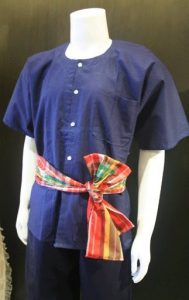
pha khian aew (Cr. siambusinessnews)
Thailand has long been a major trading hub in the Southeast Asia. Merchants from all over the world would sail to Thailand to trade their goods and return to their homelands with our renowned forest products. However, along the processes, different cultures intertwined, and languages were shared between the traders, and finally they all became a part of our vibrant Thai culture. One example of this exchange is the word “pha khao ma,” which we borrowed and made our own. Therefore, this piece of multifunctional cloth represents both our Thai culture and the history of our relationship with other countries.
From Local to the World of Fashion
In the modern world, there are more substitutes for the utilization of pha khao ma available in the market. However, having survived many transitional phrases in Thailand through the adaptation and creativity of Thai people, this traditional textile still stands strong. Now, it is developed and modified to suit the lifestyle of Thai people today. With its timeless pattern, vibrant colors, and soft texture, pha khao ma becomes an ideal material for clothes and accessories. Many Thai designers use pha khao ma’s unique patterns in their stylish clothes, hats, scarves, and bags, or in other objects such as passport covers or wallets. This makes the fabric, originally associated with locals, become more attractive to younger generations and foreigners finding local yet fashionable souvenirs to bring back home.
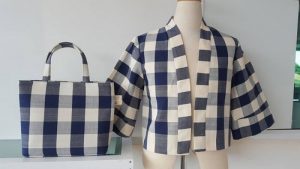
(Cr. mgronline)
What’s even better is that the beauty of pha khao ma isn’t only restricted to its homeland anymore, but it is also recognized in the global fashion world. In April 2020, the locally woven fabric, sewn into a stunning collection of garments, was introduced to the world on the international runway at Amazon Fashion Week Tokyo. Linda Charoenlarp – a Thai designer and stylist and the creator of this collection – has been working with local artisans in many provinces and together they give life to the traditional textile.

Amazon Fashion Week Tokyo (Cr. Lalalove)
As pha khao ma encapsulates Thai culture and way of life within itself, bringing it to the spotlight doesn’t only help promote Thai creativity and characteristics of each region, but also helps expand the customer base for the woven fabric, creating a sustainable job for local weavers and supporting Thai artisanship.
Similar Fabrics in Southeast Asia
As Southeast Asian countries share cultures in some way or another, similar woven fabrics are also utilized in some of our neighbors. In Cambodia, the traditional krama cloth can be adapted into many uses such as a scarf, a bandanna, a baby hammock, or even a cloth wrapping around the waist, head, and fists of Bakator fighters. Krama is worn by people of all ages and genders. It traditionally comes in a gingham pattern with red or blue color, the colors of the Cambodian national flag.
Bali is also famous for its checkered textile, poleng. Poleng means two-tone and indeed, the fabric comes in two colors – black and white, representing the philosophy in Bali that recognizes duality in all things and promotes tolerance and appreciation of differences. Black and white existing on a piece of cloth symbolizes balance and harmony in life. Poleng is not utilized for everyday purposes, but it is usually associated with ceremonies and spiritual objects. When you see a poleng cloth draped over a statue, shrine, or even a rock, it’s not just for decoration; poleng is believed to guard spirits dwelling within these objects.
Conclusion
Pha khao ma, with its timeless charm and colorful design, effortlessly captures the hearts of Thai people from all walks of life thanks to its versatility and adaptability. Serving as an auspicious item in Thai rituals and ceremonies, everyday necessities, house decorations, accessories, and fashionable everyday garments, pha khao ma truly showcases the adaptive and open nature, as well as the creativity of Thai people. As the ever-expanding list of functions for this traditional textile goes on, we can’t help but be excited about the endless possibilities that lie ahead! Moreover, the exquisite craftsmanship displayed in the simplistic yet captivating designs of each regional variation of pha khao ma is a testament to the dedication and skill of the local artisans.
The story of the “Pha Khao Ma” is a charming facet of Thai culture and heritage. The vibrant design of this fabric reflects Thai artistic ingenuity, while its versatile functions reflects the Thai people’s resourcefulness. Today, pha khao ma remains a popular, with new designs and functions continuing to push this fabric to new ventures. This growth is reflective of the characteristic of openness that is inherent in Thai cultural heritage. Join us in exploring more stories of Thailand and the Thai people, as we take you on a journey to discover Thainess.
Sources:
- https://www.lib.ru.ac.th/journal/loincloth.html
- https://www.okmd.or.th/okmd-kratooktomkit/4022/
- https://www.amarintv.com/spotlight/sustainability/detail/33863#:~:text=%E0%B8%A2% E0%B8%81%E0%B8%A3%E0%B8%B0%E0%B8%94%E0%B8%B1%E0%B8%9A%E0%B8%9C% E0%B9%89%E0%B8%B2%E0%B8%82%E0%B8%B2%E0%B8%A7%E0%B8%A1%E0%B9%89%E0%B 8%B2%20%E0%B8%AA%E0%B8%B9%E0%B9%88%E0%B8%A3%E0%B8%B1%E0%B8%99%E0%B9% 80%E0%B8%A7%E0%B8%A2%E0%B9%8C%E0%B8%A3%E0%B8%B0%E0%B8%94%E0%B8%B1%E0% B8%9A%E0%B9%82%E0%B8%A5%E0%B8%81
- https://www.sacit.or.th/uploads/items/attachments/1264dbec13e4c46523e30782ad31727f/_dad7bf7737c7ad75ec00ec5506317dfe.pdf
- https://www.gadventures.com/blog/understanding-poleng-balis-traditional-textile/
- https://en.wikipedia.org/wiki/Krama
Author: Thanachporn Varapongsittikul
Editor: Tayud Mongkolrat
30 October 2023


